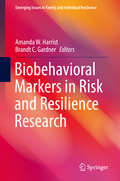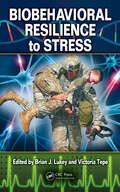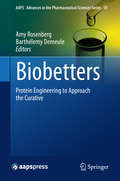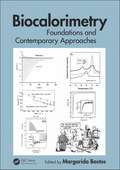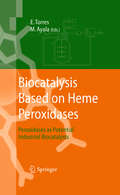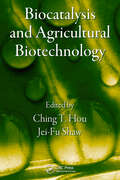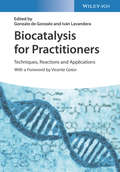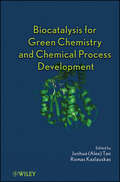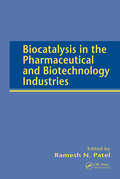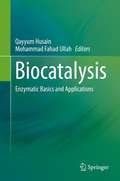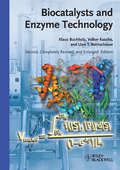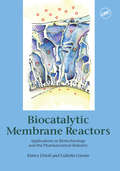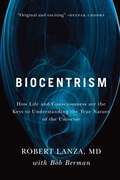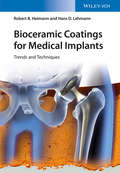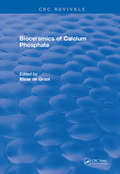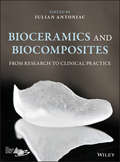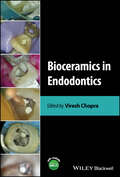- Table View
- List View
Biobehavioral Markers in Risk and Resilience Research (Emerging Issues in Family and Individual Resilience)
by Amanda W. Harrist Brandt C. GardnerThis comprehensive reference explores the current and future state of biobehavioral markers in family resilience research, with special focus on linking biological and physiological measures to behavioral and health outcomes. It brings together the latest biobehavioral data on child-parent and couple relationships, adversity, and other key areas reflecting new technological advances in biobehavioral studies and translates these findings into implications for real-world practice and policy. The contributors’ insights on biomarkers apply to emerging topics of interest (e.g., molecular genetics) as well as familiar ones (e.g., stress). Their interdisciplinary perspective helps to elaborate on risk and resilience factors for those creating the next generation of evidence-based interventions. Among the topics covered: <P><P> The immune system as a sensor and regulator of stress: implications in human development and disease <br>The psychobiology of family dynamics: bidirectional relationships with adrenocortical attunement <br>Intergenerational transmission of poverty: how low socioeconomic status impacts the neurobiology of two generations <br>The influence of teacher-child relationships on preschool children’s cortisol levels <br>Challenges and strategies for integrating molecular genetics into behavioral science <P><P>Besides its worth to researchers and practitioners studying and working with families at risk, Biobehavioral Markers in Risk and Resilience Research also has utility as a training text, offering a highly accessible presentation and discussion questions suited to classroom use.
Biobehavioral Resilience to Stress
by Victoria Tepe Brian J. LukeyMilitary service involves exposure to multiple sources of chronic, acute, and potentially traumatic stress, especially during deployment and combat. Notoriously variable, the effects of stress can be subtle to severe, immediate or delayed, impairing individual and group readiness, operational performance, and ultimately‘survival. A comprehensive co
Biobetters: Protein Engineering to Approach the Curative (AAPS Advances in the Pharmaceutical Sciences Series #19)
by Amy Rosenberg Barthélemy Demeule"Biobetters: Protein Engineering to Approach the Curative" discusses the optimization of protein therapeutic products for treatment of human diseases. It is based on the fact that though numerous important therapeutic protein products have been developed for life threatening and chronic diseases that possess acceptable safety and efficacy profiles, these products have generally not been reexamined and modified for an improved clinical performance, with enhancements both to safety and efficacy profiles. Advances in protein engineering, coupled with greatly enhanced understanding of critical product quality attributes for efficacy and safety, make it possible to optimize predecessor products for clinical performance, thereby enhancing patient quality of life and with the potential for great savings in health care costs. Yet despite such knowledge, there is little movement towards such modifications. This book examines engineering protein therapeutic products such that they exhibit an optimal, not just an adequate, clinical performance profile. Two product classes, therapeutic enzymes for lysosomal storage diseases (enzyme replacement therapies, ERT) and monoclonal antibodies (mAbs), are used as examples of what modifications to such proteins could be made to enhance clinical performance, "closer to a cure" as it were. For ERT, the key to optimizing clinical performance is to ensure the ERT is endowed with moieties that target the protein to the relevant target tissue. Thus, for Gaucher Disease, our best example of how to optimize an ERT to address a disease that manifests in specific target tissues (macrophages and monocytes), the enzyme has been extensively modified to target macrophages. For diseases such as Pompe Disease, largely a disorder of muscle, optimal performance of ERT will depend on endowing the enzyme with the ability to be taken up via the Mannose 6 Phosphate Receptor, and so one of the chapters in the book will discuss such approaches. Moreover, a major failure of biotechnology based products is to gain access to the CNS, a key target tissue in numerous diseases. Thus, a chapter has been devoted to strategies to access the CNS. Additionally, immune responses to therapeutic proteins can be highly problematic, eliminating the efficacy of life saving or highly effective protein therapeutics. This is especially poignant in the case of Pompe Disease wherein great improvement in muscle strength and functionality is lost following development of an immune response to the ERT with consequent patient deterioration and death. Thus, a chapter regarding protein engineering, as well as other non-clinical approaches to diminishing immunogenicity is a valuable part of the book. Monoclonal antibodies (mAbs) can be engineered to bind targets relevant to a wide variety of diseases; binding affinity, however, is only part of the equation and one of the chapters will present a molecular assessment approach that balances affinity with pharmacokinetics and manufacturability. As with other proteins immunogenicity can be problematic, being responsible for loss of efficacy of anti-TNF mAbs, often after prolonged successful treatment. The authors will also share their perspective on the consequences of physico-chemical modifications occurring to mAbs once they reach the circulation or their target, a research area open to further development from a protein engineering as well as analytical perspective. This book will also discuss novel platforms for protein therapeutics, technologies that exceed mAbs with respect to potency, and hence, potentially efficacy. These platforms consist largely of repeat domain proteins with very high affinity for their target ligands, but while potentially more efficacious, immunogenicity may be a major problem limiting use. The economics surrounding the issue of biobetters is another high-profile issue - this final chapter will explore the incentives and disincentives for developing biobetters and consider incentives that might make their pursuit more rewarding.
Biobot Analytics
by Mitchell B. Weiss Joshua Lev Krieger Raymond KluenderIn 2017, Newsha Ghaeli and Mariana Matus were deciding whether to leave their labs at the Massachusetts Institute of Technology, put other job opportunities aside, and dive full-time into founding a wastewater analysis start-up, Biobot. Ghaeli, an architect, and Matus, a computational biologist, had been turning sewage into information about "population health" and now had dreams of turning the data encoded in urine and stool into a viable and impactful business. In plainer terms, they planned to "tap into what you flush down the toilet every day." They'd been told not to. They'd been told their idea was too broad and their skills too narrow. They'd been told they had no defensible intellectual property and limited scalability. They'd been advised to choose other startups instead, and knew, as immigrants on temporary visas, if they failed at this venture, they might even have to leave the country. Despite the many hurdles and objections, Ghaeli and Matus felt mostly at ease about moving ahead. Were they missing something? Or was everyone else?
Biocalorimetry: Foundations and Contemporary Approaches
by Margarida BastosConnecting past, present, and future instrument development and use, Biocalorimetry: Foundations and Contemporary Approaches explores biocalorimetry's history, fundamentals, methodologies, and applications. Some of the most prominent calorimeter developers and users share invaluable personal accounts of discovery, discussing innovative techniques a
Biocapital: The Constitution of Postgenomic Life
by Kaushik Sunder RajanBiocapital is a major theoretical contribution to science studies and political economy. Grounding his analysis in a multi-sited ethnography of genomic research and drug development marketplaces in the United States and India, Kaushik Sunder Rajan argues that contemporary biotechnologies such as genomics can only be understood in relation to the economic markets within which they emerge. Sunder Rajan conducted fieldwork in biotechnology labs and in small start-up companies in the United States (mostly in the San Francisco Bay area) and India (mainly in New Delhi, Hyderabad, and Bombay) over a five-year period spanning 1999 to 2004. He draws on his research with scientists, entrepreneurs, venture capitalists, and policymakers to compare drug development in the two countries, examining the practices and goals of research, the financing mechanisms, the relevant government regulations, and the hype and marketing surrounding promising new technologies. In the process, he illuminates the global flow of ideas, information, capital, and people connected to biotech initiatives. Sunder Rajan's ethnography informs his theoretically sophisticated inquiry into how the contemporary world is shaped by the marriage of biotechnology and market forces, by what he calls technoscientific capitalism. Bringing Marxian theories of value into conversation with Foucaultian notions of biopolitics, he traces how the life sciences came to be significant producers of both economic and epistemic value in the late twentieth century and early twenty-first.
Biocatalysis Based on Heme Peroxidases: Peroxidases as Potential Industrial Biocatalysts
by Eduardo Torres Marcela AyalaThis monograph describes many applications of peroxidase-based biocatalysis in the biotechnology industry. The need for such a book emerges from the considerable amount of new data regarding the phylogeny, reaction mechanisms, thermodynamic characterization and structural features of fungal and plant heme peroxidases that has been generated in the past 10 years, since the last specialized book on peroxidases was published. The aim of this book is to present recent advances on such basic aspects as evolution, structure-function relation and catalytic mechanism as well as applied aspects, such as bioreactor and protein engineering, to provide the tools for rational design of enhanced biocatalysts and biocatalytic processes.
Biocatalysis and Agricultural Biotechnology
by Ching T. Hou Jei-Fu ShawWorldwide energy and food crises are spotlighting the importance of bio-based products - an area many are calling on for solutions to these shortages. Biocatalysis and Agricultural Biotechnology encapsulates the cutting-edge advances in the field with contributions from more than 50 international experts comprising sectors of academia, industry, an
Biocatalysis and Biomolecular Engineering
by Ching T. Hou Jei-Fu ShawAn expert overview of new technologies guiding the construction of a sustainable society This compendium of important insights from sixty distinguished international scholars looks at the significant advances in progressive environmental technology—especially the molecular engineering used on plants, animals, and microorganisms—as the game changer in the high-stakes race to reverse earth-damaging practices. Biocatalysis and Biomolecular Engineering covers subject matter on the latest developments in eco-friendly and energy-saving manufacturing processes with the emphasis on agricultural technology and bio-based products. Focusing its study on remedies that show promise in curing food and energy ills, this book examines groundbreaking work in various fields, such as nutraceuticals, genetic engineering of agricultural products, and bioenergy. Biocatalysis and Biomolecular Engineering: Can be used as a reference by teachers, graduate students, and industrial scientists who conduct research in bioscience and biotechnology Serves as the first book to bring together fundamentals and leading-edge technologies for the development of bio-based industrial products through biocatalysis; for example, it discusses the preparation of biofunctional micro- and nanoparticles Contains chapters by international experts from academia, industry, and government research institutes Biocatalysis and Biomolecular Engineering builds a cohesive, well thought out case for nurturing new discoveries in eco-technology by inviting critical discussion on devising viable solutions to sustaining the future wellness of humankind.
Biocatalysis for Practitioners: Techniques, Reactions and Applications
by Gonzalo De Gonzalo Iván LavanderaThis reference book originates from the interdisciplinary research cooperation between academia and industry. In three distinct parts, latest results from basic research on stable enzymes are explained and brought into context with possible industrial applications. Downstream processing technology as well as biocatalytic and biotechnological production processes from global players display the enormous potential of biocatalysts. Application of "extreme" reaction conditions (i.e. unconventional, such as high temperature, pressure, and pH value) - biocatalysts are normally used within a well defined process window - leads to novel synthetic effects. Both novel enzyme systems and the synthetic routes in which they can be applied are made accessible to the reader. In addition, the complementary innovative process technology under unconventional conditions is highlighted by latest examples from biotech industry.
Biocatalysis for green chemistry and chemical process development
by Junhua Alex Tao Romas KazlauskasThis book describes recent progress in enzyme-driven green syntheses of industrially important molecules. The first three introductory chapters overview recent technological advances in enzymes and cell-based transformations, and green chemistry metrics for synthetic efficiency. The remaining chapters are directed to case studies in biotechnological production of pharmaceuticals (small molecules, natural products and biologics), flavors, fragrance and cosmetics, fine chemicals, value-added chemicals from glucose and biomass, and polymeric materials. The book is aimed to facilitate the industrial applications of this powerful and emerging green technology, and catalyze the advancement of the technology itself.
Biocatalysis in Polymer Chemistry
by Katja LoosSearching for green and environmentally friendly polymerization methods by using enzymes? This first handbook on this hot and essential topic contains the whole chain of knowledge of biocatalysis in polymer chemistry in both a comprehensive and compact form. International leading experts cover all important aspects, from enzymatic monomer synthesis to polymer modification and degradation. While the major focus of the book is on enzymatic polymerizations of the polymer classes reported so far, industrial contributions are also included, making this invaluable reading for biochemists and polymer chemists working in academia and industry.
Biocatalysis in the Pharmaceutical and Biotechnology Industries
by Ramesh N. PatelBecause enzyme-catalyzed reactions exhibit higher enantioselectivity, regioselectivity, substrate specificity, and stability, they require mild conditions to react while prompting higher reaction efficiency and product yields. Biocatalysis in the Pharmaceutical and Biotechnology Industries examines the use of catalysts to produce fine chemic
Biocatalysis: Enzymatic Basics and Applications
by Mohammad Fahad Ullah Qayyum HusainThis book introduces readers to industrially important enzymes and discusses in detail their structures and functions, as well as their manifold applications. Due to their selective biocatalytic capabilities, enzymes are used in a broad range of industries and processes. The book highlights selected enzymes and their applications in agriculture, food processing and discoloration, as well as their role in biomedicine. In turn, it discusses biochemical engineering strategies such as enzyme immobilization, metabolic engineering, and cross-linkage of enzyme aggregates, and critically weighs their pros and cons. Offering a wealth of information, and stimulating further research by presenting new concepts on enzymatic catalytic functions in basic and applied contexts, the book represents a valuable asset for researchers from academia and industry who are engaged in biochemical engineering, microbiology and biotechnology.
Biocatalysts and Enzyme Technology
by Klaus Buchholz Uwe Theo Bornscheuer Volker KascheThis second edition of a bestselling textbook offers an instructive and comprehensive overview of our current knowledge of biocatalysis and enzyme technology. The book now contains about 40% more printed content. Three chapters are completely new, while the others have been thoroughly updated, and a section with problems and solutions as well as new case studies have been added. Following an introduction to the history of enzyme applications, the text goes on to cover in depth enzyme mechanisms and kinetics, production, recovery, characterization and design by protein engineering. The authors treat a broad range of applications of soluble and immobilized biocatalysts, including wholecell systems, the use of non-aqueous reaction systems, applications in organic synthesis, bioreactor design and reaction engineering. Methods to estimate the sustainability, important internet resources and their evaluation, and legislation concerning the use of biocatalysts are also covered.
Biocatalytic Membrane Reactors: Applications In Biotechnology And The Pharmaceutical Industry
by Lidietta Giorno Enrico DrioliThis research level reference book has been co-written by Enrico Drioli, perhaps one of the world's best known researchers into membrane technology. The application of membrane technology to chemical transformation and molecular separation are beginning to be exploited in the pharmaceutical science and biotechnology industries, but there is a need for researchers and students to have up-to-date literature - and this book provides it. The book will be of interest to students of chemistry, chemical engineering, pharmacy and biotechnology.
Biocentrism: How Life and Consciousness are the Keys to Understanding the True Nature of the Universe
by Bob Berman Robert LanzaRobert Lanza is one of the most respected scientists in the world — a US News & World Report cover story called him a &“genius" and a &“renegade thinker," even likening him to Einstein. Lanza has teamed with Bob Berman, the most widely read astronomer in the world, to produce Biocentrism, a revolutionary new view of the universe. Every now and then a simple yet radical idea shakes the very foundations of knowledge. The startling discovery that the world was not flat challenged and ultimately changed the way people perceived themselves and their relationship with the world. For most humans of the 15th century, the notion of Earth as ball of rock was nonsense. The whole of Western, natural philosophy is undergoing a sea change again, increasingly being forced upon us by the experimental findings of quantum theory, and at the same time, towards doubt and uncertainty in the physical explanations of the universe's genesis and structure. Biocentrism completes this shift in worldview, turning the planet upside down again with the revolutionary view that life creates the universe instead of the other way around. In this paradigm, life is not an accidental byproduct of the laws of physics. Biocetnrism takes the reader on a seemingly improbable but ultimately inescapable journey through a foreign universe—our own—from the viewpoints of an acclaimed biologist and a leading astronomer. Switching perspective from physics to biology unlocks the cages in which Western science has unwittingly managed to confine itself. Biocentrism will shatter the reader's ideas of life--time and space, and even death. At the same time it will release us from the dull worldview of life being merely the activity of an admixture of carbon and a few other elements; it suggests the exhilarating possibility that life is fundamentally immortal. The 21st century is predicted to be the Century of Biology, a shift from the previous century dominated by physics. It seems fitting, then, to begin the century by turning the universe outside-in and unifying the foundations of science with a simple idea discovered by one of the leading life-scientists of our age. Biocentrism awakens in readers a new sense of possibility, and is full of so many shocking new perspectives that the reader will never see reality the same way again.
Bioceramic Coatings for Medical Implants
by Robert B. Heimann Hans D. LehmannReflecting the progress in recent years, this book provides in-depth information on the preparation, chemistry, and engineering of bioceramic coatings for medical implants. It is authored by two renowned experts with over 30 years of experience in industry and academia, who know the potentials and pitfalls of the techniques concerned.Following an introduction to the principles of biocompatibility, they present the structures and properties of various bioceramics from alumina to zirconia. The main part of the work focuses on coating technologies, such as chemical vapor deposition, sol-gel deposition and thermal spraying. There then follows a discussion of the major interactions of bioceramics with bone or tissue cells, complemented by an overview of the in-vitro testing methods of the biomineralization properties of bioceramics. The text is rounded off by chapters on the functionalization of bioceramic coatings and a look at future trends.As a result, the authors bring together all aspects of the latest techniques for designing, depositing, testing, and implementing improved and novel bioceramic coating compositions, providing a full yet concise overview for beginners and professionals.
Bioceramic Materials in Clinical Endodontics
by Josette Camilleri Saulius DrukteinisThis book focuses on hydraulic calcium silicate-based materials available in clinical dentistry, used as pulp capping materials, root canal sealers, root-end fillers, or root repair materials and which offer improved properties and easier clinical application compared with the original mineral trioxide aggregate. The book introduces the current classification of bioceramic materials and explains their characterization and their physicochemical and biological properties. Thereafter, the various clinical applications of these materials are discussed in depth with reference to the evidence base. The coverage includes applications in endodontic treatments and complications, traumatic dental injuries, management of the vital pulp in both dentitions, and regenerative endodontic procedures. Apart from presenting the latest research on hydraulic calcium silicate-based materials, Bioceramic Materials in Clinical Endodontics promotes an essential balance between basic laboratory and clinical research. It will thus be an important reference for materials science specialists, clinical researchers, and clinicians.
Bioceramics
by James F. ShackelfordThe main sections/chapters of the book focus on the composition of nine types of bioceramics, other simple oxides and more and the medical applications of these materials in orthopaedics, dentistry and the treatment of cancerous tumors.
Bioceramics Calcium Phosphate
by K. de GrootThe first chapters are fundamental, in that the physical chemistry of calcium phosphate salts is discussed, along with mineralization (with emphasis on teeth) and remodelling of mineralized tissues. Thereafter follows a treatment of the influence of implants o surrounding hard tissues. This topic is followed by a chapter on preparation methods and biomechanical and biological aspects of calcium phosphate implants. In conclusion, two chapters are devoted to (possible) dental and medical applications. It is hoped that basic researchers can use the book in their efforts to improve this promising class of materials further, and that clinicians are inspired to define further possibilities and � at least as important � limitations.
Bioceramics and Biocomposites: From Research to Clinical Practice
by Iulian AntoniacProvides comprehensive coverage of the research into and clinical uses of bioceramics and biocomposites Developments related to bioceramics and biocomposites appear to be one the most dynamic areas in the field of biomaterials, with multiple applications in tissue engineering and medical devices. This book covers the basic science and engineering of bioceramics and biocomposites for applications in dentistry and orthopedics, as well as the state-of-the-art aspects of biofabrication techniques, tissue engineering, remodeling, and regeneration of bone tissue. It also provides insight into the use of bionanomaterials to create new functionalities when interfaced with biological molecules or structures. Featuring contributions from leading experts in the field, Bioceramics and Biocomposites: From Research to Use in Clinical Practice offers complete coverage of everything from extending the concept of hemopoietic and stromal niches, to the evolution of bioceramic-based scaffolds. It looks at perspectives on and trends in bioceramics in endodontics, and discusses the influence of newer biomaterials use on the structuring of the clinician’s attitude in dental practice or in orthopedic surgery. The book also covers such topics as biofabrication techniques for bioceramics and biocomposites; glass ceramics: calcium phosphate coatings; brain drug delivery bone substitutes; and much more. Presents the biggest trends in bioceramics and biocomposites relating to medical devices and tissue engineering products Systematically presents new information about bioceramics and biocomposites, developing diagnostics and improving treatments and their influence on the clinicians' approaches Describes how to use these biomaterials to create new functionalities when interfaced with biological molecules or structures Offers a range of applications in clinical practice, including bone tissue engineering, remodeling, and regeneration Delineates essential requirements for resorbable bioceramics Discusses clinical results obtained in dental and orthopedic applications Bioceramics and Biocomposites: From Research to Use in Clinical Practice is an excellent resource for biomaterials scientists and engineers, bioengineers, materials scientists, and engineers. It will also benefit mechanical engineers and biochemists who work with biomaterials scientists.
Bioceramics in Endodontics
by Viresh ChopraBioceramics in Endodontics Practical reference book in the emerging field of endodontics, focusing on overall makeup of dental bioceramics and relevant clinical situations in endodontics where various forms of bioceramics has been used to treat teeth successfully. Bioceramics in Endodontics is a highly unique resource that blends together detailed information on the physico-chemical and biological properties of bioceramics with their clinical application in endodontics, exploring history and chemistry, mechanical properties, advantages of bioceramics over other materials, and clinical cases with high definition pictures and videos demonstrating their usage across wide variety of clinical situations in endodontics. Written by highly qualified authors with significant experience in the field, Bioceramics in Endodontics includes information on: Material characteristics of bioceramics that Endodontists/Clinicians should be aware of Evidence based decisions between coneless and coned obturations, and healing of periapical lesions over a recall period of 3-5 years Endodontic treatment of patients using bioceramic sealers Endodontic mishaps treated with bioceramic repair material Evidence based approach for apexification using bioceramics Use of bioceramics as a root end filling material and guidelines guidelines to finding new applications for bioceramics Comparison of Bioceramics with gold standard endodontic materials A highly unique exploration into the subject, Bioceramics in Endodontics provides an essential core overview of the field of bioceramics in endodontics and related applications, making it a must-have resource for dental practitioners, along with undergraduate and postgraduate students in endodontics and other related programs of study.
Bioceramics, Biomimetic and Other Compatible Materials Features for Medical Applications (Engineering Materials)
by Po-Yu Chen Ziqi Sun Stevo Najman Vojislav Mitić Thomas Groth Mike Barbeck Branislav RandjelovićThis book reports on advanced biomaterials such as bioceramics, hydrogels, biopolymers, nanomaterials, membranes, and other compatible materials for medical applications. It introduces materials as bioactive coatings that utilize or mimic natural mechanisms and structures important for tissue and organ healing and repair. One section of the book is devoted to bone substitutes and osteogenic biomaterials. It also describes biomaterial-cell-tissue interactions, which are of critical importance for various applications in regenerative medicine, orthopedics, and implant functions. The chapters present fabrication methods and testing of various materials for medical applications. Special emphasis is given to natural patterns, theoretical models, and new insights into material characterization, particularly on fractal natural boundaries and mimicry designs taken from nature and implemented in photonics science and engineering. This multidisciplinary book is written by leading researchers and experts in their fields, and serves researchers, students, physicians, and engineers.
Biochar
by Bruckman Viktor J. Varol Esin Apaydın Uzun Başak B. Jay LiuClimate change poses a fundamental threat to humanity, and thus solutions for both mitigation and adaptation strategies are becoming increasingly necessary. Biochar can offer a range of environmental services, such as reclamation of degraded land, improvement of soil fertility and carbon sequestration. However, it also raises questions, regarding sustainable feedstock provision, biomass pyrolysis, and soil amendment. These questions, among various others, are addressed in this state-of-the-art compendium. Covering a broad geographical range, with regional assessments from North America, Europe, the Near East, and Southeast Asia, this interdisciplinary volume focuses on the entire biochar supply chain, from the availability and economics of biomass resources, to pyrolysis, and ultimately to the impacts on soil properties. The combination of theory with practical examples makes this a valuable book for researchers, policymakers, and graduate students alike, in fields such as soil science, sustainable development, climate change mitigation, biomass and bioenergy, forestry, and environmental engineering.
